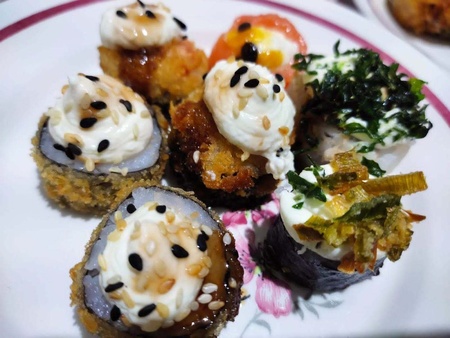I grew up in a Japanese-Brazilian environment in which my father is an Issei and my mother is a Nisei. However, living in Brazil with a family that has Japanese customs you will have an identity crisis because you don't fit in anywhere or you will have the best of both worlds. In my case, I only see advantages in this cultural diversity, especially with regard to food.
For those who don't know Japanese cuisine, you don't know what gastronomy is. Just like those who don't know Brazilian cuisine. Brazil is a geographically large country so there is diversity in terms of a lot of spices, vegetables and fruits. Therefore, the flavors are also rich and varied.
Beans in Brazil is a dish that cannot be missed in the authentic Brazilian home; usually onion and garlic are added to season it. My mother makes beans with seaweed; mixing a very important ingredient from Brazil and the other from Japan. Not only is this combination delicious, it is also healthy.
Speaking of healthy foods, the Japanese have several foods that are beneficial to health. Green tea, for example, was not restricted only to Nikkei, it is very popular in Brazil being recommended by health professionals for its benefits.
The Japanese contributed a lot to Brazilian agriculture bringing vegetables such as the kabocha pumpkin, which is a hybrid of the pumpkin squash; the nigagori that has people calling it bitter melon; the Japanese cucumber; umeboshi and wasabi which has now started to be cultivated and sold fresh in Brazil. In addition, Japanese immigrants also brought fruits such as: persimmon, ponkan orange, fuji apple, nashi pear, among others.
The most popular foods from Brazil are: feijoada, churrasco, coxinha, brigadeiro, pastel, among others. In fact, elected several times as the best pastel in São Paulo, it is made by a Japanese born in Osaka called Kuniko Yohana, but in Brazil she is known as Maria, who says that the dough is the secret to the success of her pasteis.
I realize that one culture does not come into contact with the other without causing impacts. And when you mix Brazil with Japan the result of the influence of Japanese cuisine in Brazil can be seen in the unusual versions of sushi with mango, sushi with carambola, fried temaki, sushi with pout pepper, tilapia sashimi, guava harumaki and even sushi with Nutella.

There are Brazilian variations of Japanese food that are quite peculiar. It's Japanese cuisine shaping itself to fit the taste of Brazilians. There are some surprisingly good mixes, like sushi with leeks and cream cheese, but there are also some bizarre versions, like sushi with strawberry and Nutella. I don't particularly like sushi with fruit, curd cheese or dulce de leche, which are characteristically Brazilian ingredients.
I believe that for the Brazilian palate, Japanese cuisine is bland, there are no strong seasonings. For this it is increased with options that give more flavor and that contrast with each other. According to Soares and Gaudioso (2013), soy sauce made in Brazil is stronger, being a saltier product and Japanese soy sauce is lighter and smoother. This is mainly due to the use of different ingredients.
In Brazil, a food that has become popular mainly by the anime Naruto is dangō. Another food that has stood out recently in Brazil is the Bentō Cake in bakeries which is a mini cake that comes inside a lunch box and presents humorous messages.
Bentō Cake may not be a Japanese invention but bentō is very common and traditional for Nikkei families being featured in doramas, anime and manga. My family, for example, always takes obentō when traveling by car. It has become a tradition that when you travel and don't take obentō you have the impression that you haven't left the place.
Today aluminum bentōs are already in disuse. Current models are thermal to keep the temperature longer. But, we still have some Bachan bentōs that we still keep as a souvenir. This is another very Japanese aspect of storing things you don't use but we'll leave that for another article.
References:
SOARES, André Luis Ramos; GAUDIOSO, Tomoko Kimura. “Entre o sushi e o churrasco: gastronomia, culinária e identidade étnica entre imigrantes japoneses.” Habitus. Goiânia, v. 11, n.1, p. 77-94, jan./jun. 2013.
* * * * *
Our Editorial Committee selected this article as one of his favorite Itadakimasu 3! Nikkei Food, Family, and Community stories in Portuguese. Here is her comment.
Comment from Telma Shiraishi
I loved Meiry’s account, talking about her memories—dishes and habits that were inherited from her family. What stands out is the fusion of recipes and ingredients that create new flavors while providing us with a good look at the history and family nucleus around this axis.
My favorite segment is the one in which she talks about the typically Brazilian beans that include Japanese seaweed in their recipe. Next time I prepare beans at home, I’ll be trying out this combination myself.
In addition to references to pop culture influences that have helped to increase interest in Japanese dishes, she goes through the unique combinations found in Brazilian sushi, with lots of freestyle in the reinterpretation of recipes that have traveled the world. Meiry also strolls through the diversity of Brazilian ingredients, many of which are cultivated by the Japanese in these lands and which allow for the great variety of new combinations.
The most affective memory involves the bento meals—the flavor of traveling and of memories of her Bachan are materialized in the little metal boxes. A taste of family and of a unique identity, forged between two worlds.
© 2022 Meiry Mayumi Onohara












